© 2018 Dr. M. Sheppard
Ploughing involves much hard work. Families who own cattle plough with their oxen. Usually six oxen are used to one plough. A woman or child may lead the two front oxen, and a man drives them and steers the plough from behind. A rich family may be at a tremendous advantage as they can have more than one set of oxen and plough going at a time.
Poorer families who have only one or two cattle for ploughing may get together with other people (usually relatives) to make up a ploughing team. In this case they will plough one family's field and then move to the other family's.
Today richer families may even own tractors. Poorer families who do not have any cattle may have their field ploughed for them by a relative. First they help their cattle-
Once ploughing has started there are several taboos that are observed, and failure to respect them is treated as a serious offence and may even result in fines of cattle at the kgotla. For example livestock may not be driven through the Lands area from one area to another. If one has to drive them at this time (other than cattle to be used for ploughing/planting etc.) a wreath of a plant called mothanthanwane must be put around the animal's(s) neck or head. Failure to do this is believed to attract hail which will follow the path that the animal(s) took, and it will destroy the crops in the fields, particularly those that are just beginning to germinate. I observed this taboo being practised on two occasions during the 1979-
There is a great fear of hail during the growing season, and various other practices are avoided as they are believed to attract hail. For example bulls may not be killed during the growing season, as this can attract hail and early frosts. During the 1977-
There is a taboo against cutting certain types of wood for the same reason -
It should be mentioned that many traditional families will have their seeds doctored by their traditional doctor before planting them, this is to make sure that the seeds are not bewitched and also to protect them against destructive weather (see above) and pests when they finally germinate and are maturing. Again, certain mothusa (helper) leaves and plants are used in fields. One such mothusa tree is modubatsipe. A branch of this tree may be put in each corner of the field and perhaps in the middle, this is believed not only to have the power to protect the field against hail and early frost but also against lightning, sorcery and attack from pests (locusts etc.). I observed this in the 1979-
Another taboo is against destroying swallows' nests, even when they have built inside a house. It is believed that if these are destroyed the rain will be driven away and drought will be caused. Several times I observed these inside people's houses, causing great inconvenience, but because of the taboo they were left.
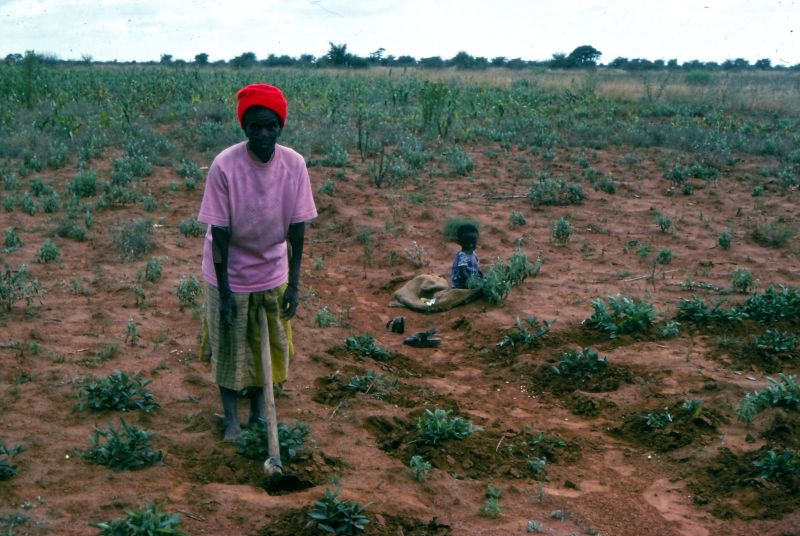
Ploughing and Planting
First Rains
These usually fall in October and November and people make preparations to go to their Lands. Men may go earlier to the Cattle posts to prepare the oxen that will be used for ploughing at the Lands, and also to prepare the fields at the Lands, for example clearing stumps from fields, or bushes from new fields. These first rains soften the soil so that the land can be ploughed and the oxen fatten on the new grass.
Ploughing and planting
When the rains start in earnest the Chief traditionally announced formally in a kgotla meeting that it was time for people to go to the Lands, this was called Letsema.
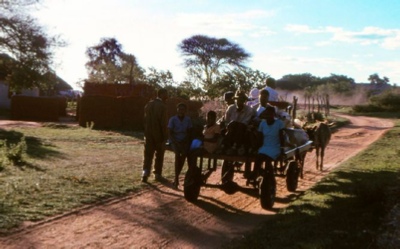
People go in ox wagons, cars, buses or any other transport that they own or hire, or may even go on foot. They take with them food and seed and personal effects. Nowadays most children attend primary school and some are at secondary school so they remain in the village, possibly with an old grandmother. If their family Lands are near enough the children may visit to help at weekends, and certainly do so during the school holidays.
After the field has been ploughed the seeds are planted. Some people still use the broadcast method but,many now use row planting. A planter is pulled by 2 oxen or a tractor. It takes about 3 days to plant an 8 acre field with oxen. Again it should be noted that families that do not own cattle are at a disadvantage as they have to wait until cattle or tractor owners have planted their own fields. For example those who own their own draught power may finish planting in November, whereas families who have to hire may not even be ploughed until after Christmas. Not only is this very disadvantageous as early frosts In May could kill crops planted late, but also if the rains are late or early they may miss them. Owners of draught power may plant or re-
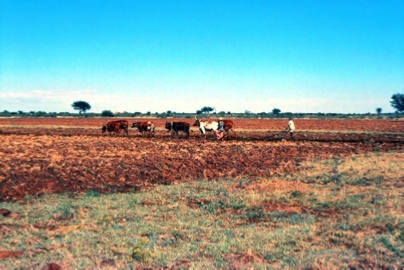


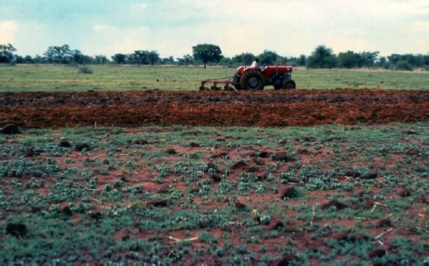
Ploughing with teams of oxen or a tractor.
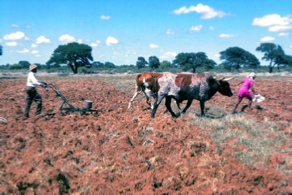

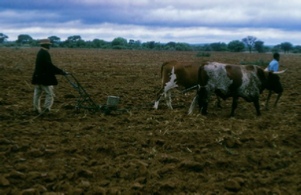
Planting with a seed drill has largely replaced broadcast sewing

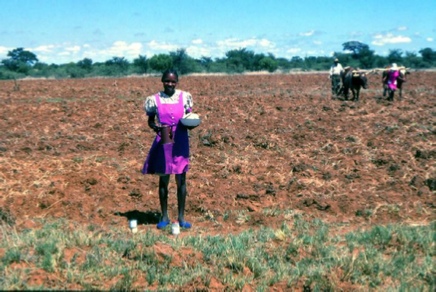
Only two oxen are required to pull a seed drill
Bringing refreshments out to the field for the planters